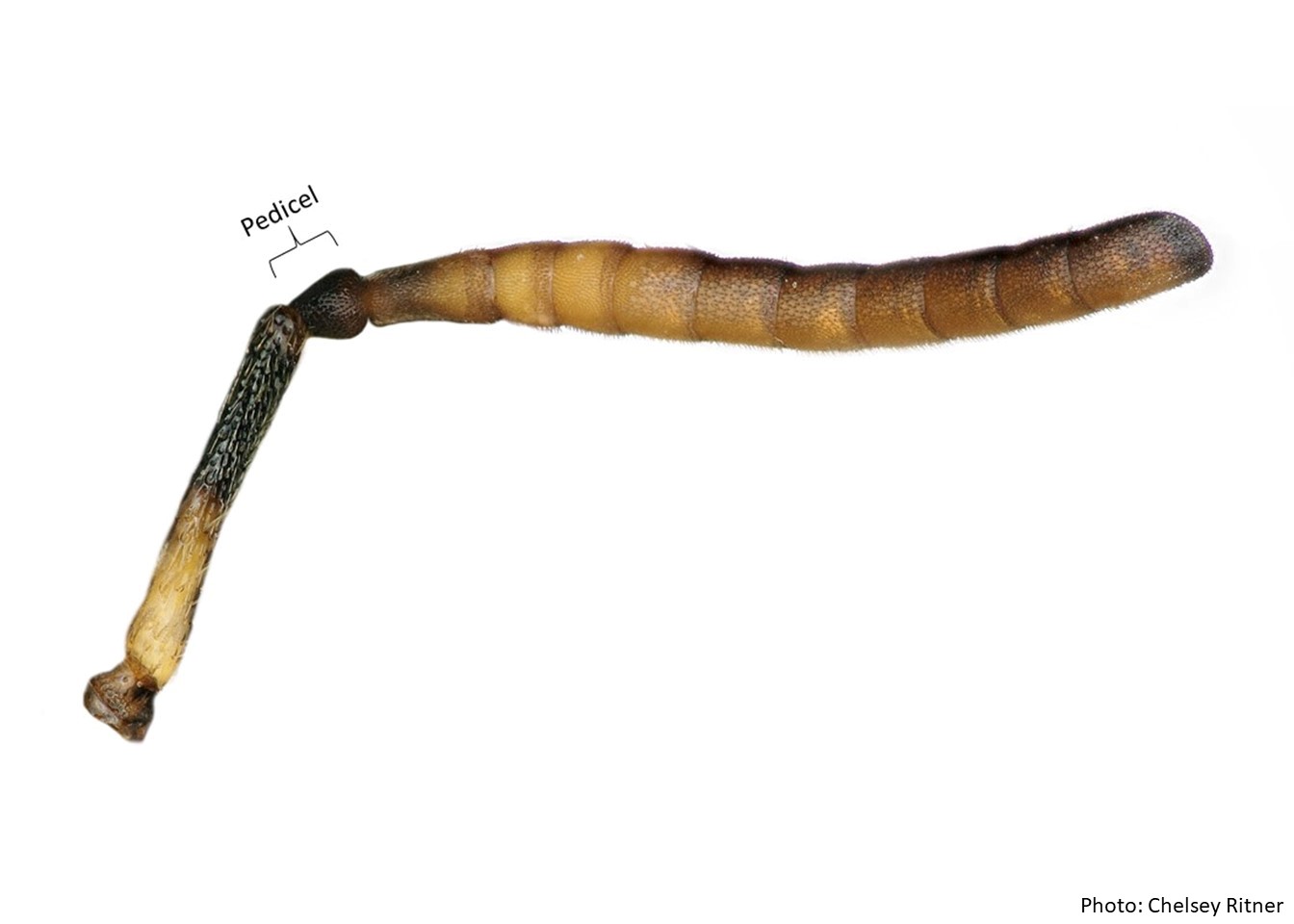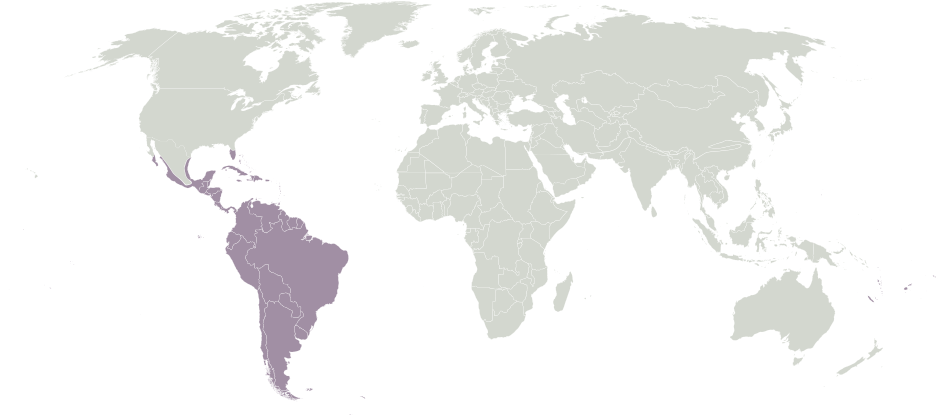Family: Megachilidae
Subfamily: Megachilinae
Tribe: Megachilini
Genus: Megachile Latreille, 1802
Subgenus: Neochelynia Schrottky, 1920
Common name: none
Megachile (Neochelynia) are slender, elongate bees with black integumentintegument:
a tough, protective outer layer
and often have white apicalapical:
near or at the apex or end of any structure
hair bandsbands:
usually referring to bands of hair or bands of color that traverse across an abdominal segment
on their tergaterga:
the segments on the top side of the abdomen, often abbreviated when referring to a specific segment to T1, T2, T3, T4, T5, T6, or T7 . They range in body length from 6.5–10 mm (Michener 2007Michener 2007:
. They range in body length from 6.5–10 mm (Michener 2007Michener 2007:
Michener, C.D. 2007. The Bees of the World (2nd ed.). Johns Hopkins University Press, Baltimore and London, 953 pp.).
(modified from Michener 2007Michener 2007:
Michener, C.D. 2007. The Bees of the World (2nd ed.). Johns Hopkins University Press, Baltimore and London, 953 pp.; Gonzalez 2008Gonzalez 2008:
Gonzalez, V.H. 2008. Phylogeny and classification of the bee tribe Megachilini (Hymenoptera: Apoidea: Megachilidae), with emphasis on the genus Megachile. Thesis: Department of Ecology and Evolutionary Biology and the College of Liberal Arts and Science of the University of Kansas: 1-274.)
 without apicalapical:
without apicalapical: with few or no erect hairs in profile.
with few or no erect hairs in profile. .
. preapicalpreapical:
preapicalpreapical:Megachile (Neochelynia) may be confused with bees within the subgenus Megachile (Rhyssomegachile) in their general appearance (Michener 2007Michener 2007:
Michener, C.D. 2007. The Bees of the World (2nd ed.). Johns Hopkins University Press, Baltimore and London, 953 pp.). Megachile (Neochelynia) females can be differentiated from Megachile (Rhyssomegachile) by the lack of erect hairs on T6T6:
the segments on the top side of the abdomen, often abbreviated when referring to a specific segment to T1, T2, T3, T4, T5, T6, or T7 and by the four-toothed mandibles in both sexes (Michener 2007Michener 2007:
and by the four-toothed mandibles in both sexes (Michener 2007Michener 2007:
Michener, C.D. 2007. The Bees of the World (2nd ed.). Johns Hopkins University Press, Baltimore and London, 953 pp.).
Megachile (Neochelynia) are known to visit flowers of Lamiaceae and Fabaceae (Aluri et al. 1997Aluri et al. 1997:
Aluri, J.S.R., M.I. Vergara-Santana, and S.L. Juarez. 1997. Floral ecology, carinal-lobe release, pollination and reproductive success in the wild and domesticated forms of Hyptis suaveolens (L.) Poit. (Lamiaceae) in Mexico. Plant Species Biology 12: 61-68.; Frankie et al. 1997Frankie et al. 1997:
Frankie, G.W., S.B. Vinson, M.A. Rizzardi, T.L. Griswold, S. O#39;Keefe, and R.R. Snelling. 1997. Diversity and abundance of bees visiting a mass flowering tree species in disturbed seasonal dry forest, Costa Rica. Journal of the Kansas Entomological Society: 281-296.).
Nesting behavior is unknown.
Megachile (Neochelynia) consists of 16 species (Moure et al. 2020Moure et al. 2020:
Moure, J.S., G.A.R. Melo, and A. DalMolin. 2020. Megachilini Latreille, 1802. In Moure, J.S., D. Urban, and G.A.R. Melo. Catalogue of Bees (Hymenoptera, Apoidea) in the Neotropical Region - online version. http://www.moure.cria.org.br/catalogue. Accessed Aug/19/2020.).
There are no known invasives.
Megachile (Neochelynia) are found in North and South America. They range from the southwestern U.S. to Paraguay and Brazil (Michener 2007Michener 2007:
Michener, C.D. 2007. The Bees of the World (2nd ed.). Johns Hopkins University Press, Baltimore and London, 953 pp.; Rasmussen et al 2009).

Distribution map generated by Discover Life -- click on map for details, credits, and terms of use.
Aluri, J.S.R., M.I. Vergara-Santana, and S.L. Juarez. 1997. Floral ecology, carinal-lobe release, pollination and reproductive success in the wild and domesticated forms of Hyptis suaveolens (L.) Poit. (Lamiaceae) in Mexico. Plant Species Biology 12: 61-68.
Frankie, G.W., S.B. Vinson, M.A. Rizzardi, T.L. Griswold, S. O'Keefe, and R.R. Snelling. 1997. Diversity and abundance of bees visiting a mass flowering tree species in disturbed seasonal dry forest, Costa Rica. Journal of the Kansas Entomological Society: 281-296.
Gonzalez, V.H. 2008. Phylogeny and classification of the bee tribe Megachilini (Hymenoptera: Apoidea: Megachilidae), with emphasis on the genus Megachile. Thesis: Department of Ecology and Evolutionary Biology and the College of Liberal Arts and Science of the University of Kansas: 1-274.
Michener, C.D. 2007. The Bees of the World (2nd ed.). Johns Hopkins University Press, Baltimore and London, 953 pp.
Moure, J.S., G.A.R. Melo, and A. DalMolin. 2020. Megachilini Latreille, 1802. In Moure, J.S., D. Urban, and G.A.R. Melo. Catalogue of Bees (Hymenoptera, Apoidea) in the NeotropicalNeotropical:
biogeographic region that includes South and Central America, the Caribbean Islands, southern Florida, and the southern Mexican lowlands Region - online version. http://www.moure.cria.org.br/catalogue. Accessed Aug/19/2020.
Region - online version. http://www.moure.cria.org.br/catalogue. Accessed Aug/19/2020.
Rasmussen, C., B.R. Garcete-Barrett, and R.B. Goncalves. 2009. Curt Schrottky (1874–1937): South American entomology at the beginning of the 20th century (Hymenoptera, Lepidoptera, Diptera). Zootaxa 2282(1): 1-50.